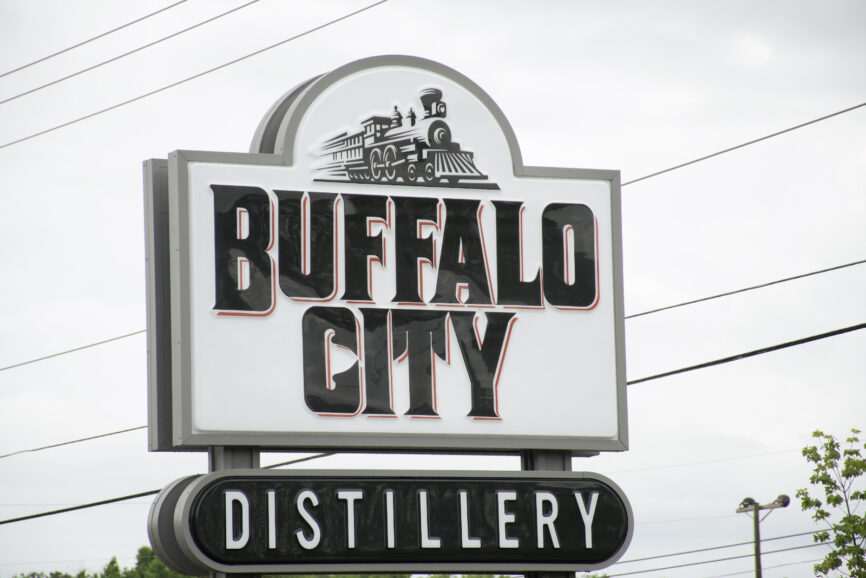Buffalo City Distillery in Point Harbor
The name reflects some history of the area, as does Buffalo City Distillery, for that matter.

A few hundred years ago about the best way to bring corn to market after a harvest was to make a mash out of it, let it ferment, and run it through a potstill a few times until a clear and potent whiskey emerged. That, at least, was the way it was done before refrigeration and transportation systems made moving a few thousand bushels of corn across the country possible.
A good argument could be made that process was the original farm-to-bottle marketing strategy, although it’s really doubtful that 18th-century farmers would think of their crop that way.
But that’s how Buddy Byrum, the owner of Buffalo City Distillery in Point Harbor, views what he’s doing. He grows his corn on his family farm in Hyde County, turns it into mash, and right now, there are a few dozen white oak barrels waiting for the moment when Buddy decides, “Yes. That’s the bourbon I want.”
The distillery just opened its door a few months ago, so there isn’t any bourbon yet. Some of that is because Buddy has made it a point not to sell anything that he doesn’t believe is the best it can be.
And some of it is how regulated the making of bourbon is—the whiskey must be a minimum of 51% corn whiskey. After that, whatever flavor the distillery is looking for will determine how much rye, wheat, or whichever grain is used will go into the bottle. There is also the aging—bourbon, by law, must be aged in American white oak barrels, and that takes some time.
But don’t despair. There are some very nice spirits available at the distillery for immediate consumption.
The East Lake Whiskey is made with Buddy’s corn. He distilled some of his corn even before he opened his doors, blending it with some rye whiskey, and it has turned out a very nice drink. It has some of the rough edges that rye whiskey tends to have, but it is indeed a well-made spirit.

The name reflects some history of the area, as does Buffalo City Distillery, for that matter.
Back during Prohibition—1920-1933—Buffalo City was a center of bootlegging. Situated on the Dare County mainland where Alligator River National Wildlife Refuge is now located, it was a one-time logging town whose heyday was a good 10 or 15 years in the past when Prohibition began.
About the only way the few hundred residents could earn a living was to make whiskey, and evidently, they made some of the best around. Occasionally they would make corn whiskey, but what they were really known for was their rye whiskey. That area of Dare County is known as East Lake, and according to legend, the cry went up and down the East Coast from New York to Philadelphia and Baltimore for some of that East Lake Whiskey.
It was a rye whiskey that they were making; that’s what those eastern markets wanted, and that’s what they produced.
The East Lake Whiskey is not going to be a permanent part of the Buffalo City lineup. At some point, the farm-to-bottle bourbon should be ready. When that happens, the East Lake Whiskey will no longer be produced.
Whiskey is not the only spirit made from Buddy’s corn. He also makes a crystal clear vodka as well.
Vodka lives in a bit of a strange place in the world of spirits. It’s a highly distilled product—on a tour of the distillery, Buddy mentioned that it takes significantly longer to make vodka than corn whiskey or almost any other whiskey.
The Buffalo City Distillery distills its vodka three times, ending up with a potent 95% clear liquid—that’s 190 proof. That’s not what goes into the bottle. The distillate is then cut with purified water to 80 proof.
The process that Buddy uses is very similar to how almost all premium vodkas are made—although he does add filtration steps that usually are not included. During the tour of the distillery, he also mentioned that vodka is made from whatever is available, which is why Russian or Polish vodka is often made from potatoes. That’s what they have; that’s what they use to make vodka.
Vodka is clear because it’s not aged. It is aging in barrels that give whiskeys their distinctive color.
The retail store and tasting room stocks flavored whiskies and vodkas as well as the straight stuff. Tastings are also offered, including flights of what is on the shelf—and some very nice mixed drinks.
There is a very nice outdoor picnic area behind the retail store—with some live music from time to time. It makes for a great place to visit, relax and review our nation’s story while sipping on a locally-made drink of history.
